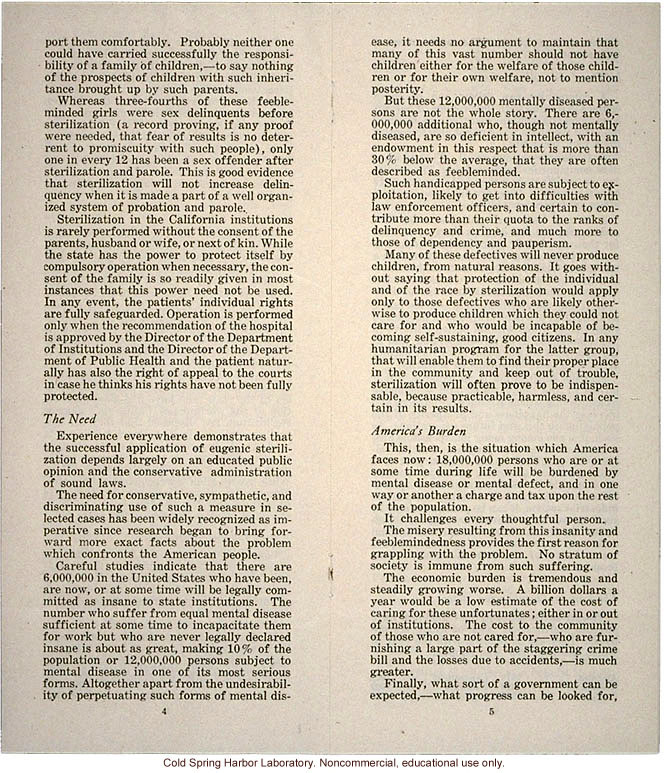[left side]
port them comfortably. Probably neither one could have carried successfully the responsibility of a family of children, -- to say nothing of the prospects of children with such inheritance brought up by such parents.
Whereas three-fourths of these feebleminded girls were sex delinquents before sterilization (a record proving, if any proof were needed, that fear of results is no deterrent to promiscuity with such people), only one in every 12 has been a sex offender after sterilization and parole. This is good evidence that sterilization will not increase delinquency when it is made a part of a well organized system of probation and parole.
Sterilization in California institutions is rarely performed without the consent of the parents, husband, wife, or next of kin. While the state has the power to protect itself by compulsory operation when necessary, the consent of the family is so readily given in most instances that this power need not be used. In any event, the patients' individual rights are carefully safeguarded. Operation is performed only when the recommendation of the hospital is approved by the Director of the Department of Institutions and the Director of the Department of Public Health and the patient naturally has also the right of appeal to the courts in case he thinks his rights have not been fully protected.
The Need
Experience everywhere demonstrates that the successful application of eugenic sterilization depends largely on an educated public opinion and the conservative administration of sound laws.
The need for conservative, sympathetic, and discriminating use of such a measure in selected cases has been widely recognized as imperative since research began to bring forward more exact facts about the problem which confronts the American people.
Careful studies indicate that there are 6,000,000 in the United States who have been, are now, or at some time will be legally committed as insane to state institutions. The neber who suffer from equal mental disease sufficient at some time to incapacitate them for work but who are never legally declared insane is about as great, making 10% of the population or 12,000,000 persons subject to mental disease in one of its most serious forms. Altogether apart from the undesirability of perpetuating such forms of mental disease,
[right side]
it needs no argument to maintain that many of this vast number should not have children either for the welfare of those children or for their own welfare, not to mention posterity.
But these 12,000,000 mentally diseased persons are not the whole story. There are 6,000,000 additional who, though not mentally diseased, are deficient in intellect, with an endowment in this respect that is more than 30% below the average, that they are often described as feebleminded.
Such handicapped persons are subject to exploitation, likely to get into difficulties with law enforcement officers, and certain to contribute more than their quota to the ranks of delinquency and crime, and much more to those of dependency and pauperism.
Many of these defectives will never produce children, from natural reasons. It goes without saying that protection of the individual and of the race by sterilization would apply only to those defectives who are likely otherwise to produce children which they could not care for and who would be incapable of becoming self-sustaining, good citizens. In any humanitarian program for the latter group, that will enable them to find their proper place in the community and keep out of trouble, sterilization will often prove to be indispensable, because practicable, harmless, and certain in its results.
America's Burden
This, then, is the situation which America faces now: 18,000,000 persons who are or at some time during life will be burdened by mental disease or mental defect, and in one way or another a charge and tax upon the rest of the population.
It challenges every thoughtful person.
The misery resulting from this insanity and feeblemindedness provides the first reason for grappling with the problem. No stratum of society is immune from such suffering.
The economic burden is tremendous and steadily growing worse. A billion dollars a year would be a low estimate of the cost of caring for these unfortunates; either in or out o institutions. The cost to the community of those who are not cared for, -- who are furnishing a large part of the staggering crime bill and the losses due to accidents, -- is much greater.
Finally, what sort of a government can be expected, -- what progress can be looked for,
5
[end]


